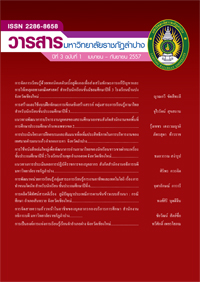การจัดสายความก้าวหน้าในอาชีพของบุคลากรกองบริการการศึกษา สำนักงานอธิการบดี มหาวิทยาลัยราชภัฏลำปาง
คำสำคัญ:
การจัดสายความก้าวหน้าในอาชีพของบุคลากรกองบริการการศึกษา, career paths for educational services division personnelบทคัดย่อ
-
Career paths for Educational Services Division personnel, Office of the President, Lampang Rajabhat University
This independent study had the objectives to study the career paths of the personnel in the Educational Service Division (ESD) and to explore the problems, barriers and recommendations for the study of the career paths for the personnel in the ESD, Office of the President (OP), Lampang Rajabhat University (LPRU). The author collected data from the sample group consisted of personnel in the ESD, heads of work group, general administrators, educational officers, computer officers and administrative operators totaled 20 persons by using unstructured indepth interviews and governmental documentary data of the ESD, OP, LPRU. The findings were: 1) the study of the organizational structure and work positions in the organizational structure of the personnel consisted of general administration group, educational service group, registration and evaluation group, academic development group, graduate studies administration group, cooperative education group and general education group and the operations were under the supervision of the director of the ESD. 2) Work position analysis: extents and duties of each position were according to the characteristics of each work group with specific qualifications as per the application and selection consisted of 7 positions of group leader, 2 positions of general administrators, 6 positions of educational officers, 3 positions of computer officers and 2 positions of administrative operators. 3) Work group structure: the structure of ESD could be divided into 4 work groups and in each work group could be crosstraining to learn, adjust and change according to the similar work that could be transferred or exchanged and 4) career advancement specifications could be divided into 2 formats: traditional career advancement by promoting or moving to the positions within the original path responsible by the 4 work groups according to the position specification standards and open career advancement in the forms of transfer or exchange of the 4 work groups and could be promoted to the position of group heads according to the knowledge, abilities and suitability.
The study also found significant problems as following: 1) the work of some personnel in some positions of the ESD did not follow the organizational structure and affected the studies of the works done, position specifications and position levels. 2) The writings of the work descriptions, extents of duties and responsibilities of the positions were not in the same directions or frameworks so they created confusion and delay in the work analysis. 3) In the collections of organizational structure, work positions and work analysis; some information was not correct so there were mistakes in the work group division. 4) The format for the open career advancement paths to work group head positions did not have a clear framework. The recommendations were: 1) There should be the information on knowledge and understanding in the organizational structure, work positions and position levels for the personnel. 2) There should be guidelines for the personnel in the writings of work description extents of duties and responsibilities and appropriate framework. 3) There should be data collection processes that are clear and detailed with the understanding in the writings of work descriptions, extents of duties and responsibilities and in the grouping of work that depends on the organizational characteristics, administrative flexibility and mutual agreements of the organizational executives and 4) there should be a criteria that specifies the standard for going into the work head positions and there should be an office that supervises and gives advice in the processes to go into the higher work positions or more stable career advancement paths.ดาวน์โหลด
รูปแบบการอ้างอิง
ฉบับ
ประเภทบทความ
สัญญาอนุญาต
บทความลิขสิทธิ์ของวารสารมหาวิทยาลัยราชภัฎลำปาง






